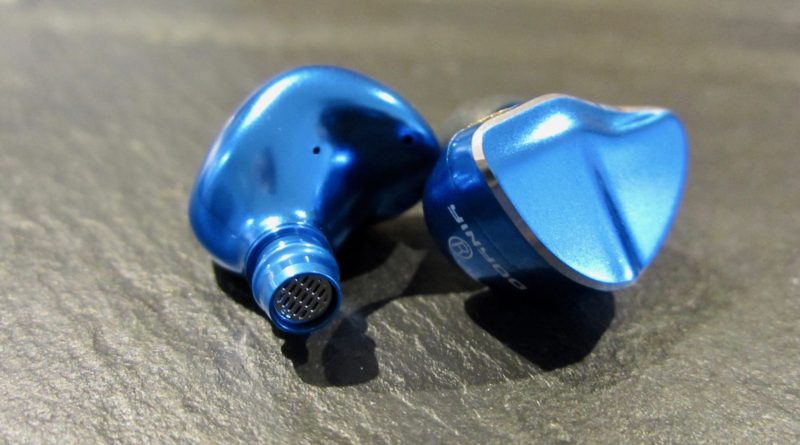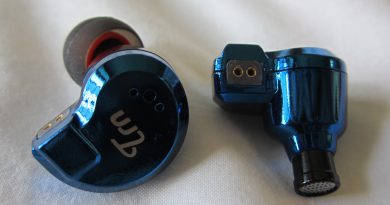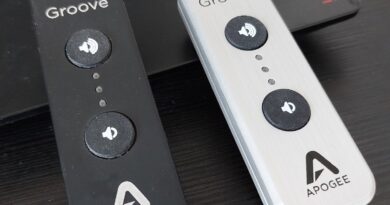Yinyoo D2B4 v2 Review – You May Ask Yourself…
Pros – Construction, comfort, cable (though a bit bulky), tonal balance.
Cons – Bass a bit soft, treble a bit hashy/hissy, mids seem distant, technicalities do not cut it.
SUMMARY
The Yinyoo D2B4 (updated version) is a slightly bass heavy but otherwise neutral hybrid over-the-ear IEM of excellent construction and good comfort that sells for $US186.25 (regular price). The nice tonality is somewhat let down by the timbre at both ends of the range, which for the price is disappointing.
UPDATE: The Yinyoo D2B4, out of the box, are flawed because the feature the “wrong” tuning filters and eartips. How turn these into good sounding earphones, read our UPDATED REVIEW.
SPECIFICATIONS (FROM DIFFERENT SHEETS)
- Product Name: Yinyoo D2B4 in-ear earphone
- Earphone Type: in-ear hybrid, 2 coaxial dynamic bass drivers (10 mm) & 4 balanced-armature mid & treble drivers
- Impedance: 19 Ω +/- 2% @ 1 kHz (but see below)
- Sensitivity: 102 dB/mW
- Frequency Range: 20-40 kHz (whatever that means)
- Distortion: 12% or <3% @ 1 kHz @ 1mW, take your pick (see below)
- Interface: 3.5mm TRS straight plug, gold plated
- Connector: MMCX
- Cable: 1.2 m ± 3 cm; silver-plated 4-core copper, no microphone
- Colours: black or blue
- Price: $93.13 — 186.25
- Purchase Link Aliexpress
- Purchase Link Amazon
As is usual with single-number specifications they’re mostly meaningless or just wrong. What exactly happens at 20 Hz and 40 kHz? And 12% distortion?? Where does that number come from? The ‘<3% …’ figure is more conventional but at 1mW this is a higher SPL level than you’d want to be listening at. Even on my noisy system at a more reasonable 85 dB, THD at 1 kHz is <1%. It’s unusual and welcome that the frequency of the impedance figure is quoted, but as with most BA or hybrid earphones it varies quite a bit across the range. Measuring shows it’s ~31 ohms through the bass, dropping through the midrange to around ~9 ohms in the treble (the NiceHCK M6 is similar). This >3x difference will interact with sources with higher output impedance to boost the bass and lower mids relative to the treble as shown on the graph below (the impedance vs frequency curve is in brown). For reference – the iPhone 6 headphone jack has 3.2 ohms output impedance, iPhone 5 is 4.5, Topping NX3S is around 5, and Macbook headphone jacks and some Topping desktop amplifiers are around 10.

IN THE BOX…
…are the two earpieces, cable, 3 pairs of each wide-vote and narrow-bore eartips (S, M. L), and a sturdy case. Note that the v2’s cable is different from that of the earlier version.

BUILD
These are very classy looking, smooth coated, machined aluminum ear-bowl shaped shells with two rear vents per side and MMCX connectors for the cables. Unlike the NiceHCK M6, the nozzles/filters (5 mm apertures) are not removable. The cable is a nicely flexible but rather thick affair that, with its braiding below the sturdy splitter block and large 3.5 mm plug, is on the whole rather bulky. The earpieces and cable together give an overall impression of quality and durability.
ERGONOMICS
These fit my ears well and are comfortable. The memory wire on the connector ends strikes a nice balance of being stiff enough to keep its shape yet flexible enough to be easily bent into a new one, and the rest of the cable is flexible, drapes well, and has low microphonics. I’d have no problem wearing these for long sessions.
SOURCE AND EARTIPS
These were easy to drive from my phone, an old Samsung Galaxy S4 (1.2 ohm output impedance). Given that, I didn’t try another source.
The two sets of S, M & L tips included are quite different. The black ones (thin, soft, “custom medical-grade hypoallergenic silicone”) are about 1 mm shallower than the grey ones (thicker, less flexible) and have stems another 1 mm shorter, the combined effect being that the nozzles are almost up at the openings of the black tips but about 2mm back from the openings of the others. In addition, the apertures of the grey tips are narrower, around 3 mm. The medium black tips fitted me well, were comfortable, and gave me an insertion depth that isolated well. Quick measurements with the grey tips show these reinforce the treble, which is opposite to what I expected and not desirable, so I didn’t try them.
SOUND
The tonal balance of the Yinyoo D2B4 is pretty good (see below): bass is mildly boosted but not overdone, the 2-5k area is elevated about the right amount, and the drop through the treble starts at about the right place and is around the right depth (could maybe be a little lower around 10k). On our plastic-tube couplers and in my ears, this signature is fairly neutral (the bass could stand to be around 3-5 dB lower). This is good, because many hybrid/BA earphones don’t respond well to equalization.

Unfortunately, timbre and technicalities don’t come up to the same standard. The bass is somewhat loose and muddy; and while the treble doesn’t have the overly-fast decay of many BA implementations (the NiceHCK M6, a similarly-constructed earphone, is guilty of this), it’s hashy/hissy and there’s accentuated sibilance with problematic recordings. In addition, the mids seem somehow distant. The combination of all this doesn’t help imaging and soundstage, which are imprecise; dynamics, which are soft; and detail resolution, which is lacking. There’s also that classic hybrid sense of incoherence – the feeling you’re listening not to one earphone but to many different ones within the same enclosure. Given the even tonality, all this is disappointing.
CONCLUDING REMARKS
These have solid construction and a nice cable, good comfort and isolation, good looks and an even tonality. Given the downsides, though, even the ‘discount’ price is too steep. While I appreciate the construction and fit of the Yinyoo, sound quality considerations come first and make me ask myself if I’m alone in wondering how much demand there’ll be in the relatively expensive machined-aluminum, multi-driver space.
DISCLAIMER
The review unit was provided by Yinyoo upon their suggestion — we at Audio Reviews thank them for that. Note that this particular specimen incorporates the latest retuning as of 2019-03-20 including a new cable. The sole purpose of this review was to independently test the Yinyoo D2B4’s technical and practical capabilities. Following the review, Audio Reviews offered to return the unit to Wooeasy but they didn’t take it back.
Our generic standard disclaimer







Several MacBooks’ and iMacs’ output impedance is in fact below 1 Ohm [JK: I accidentally deleted this comment by temp@first-email.net and put it in under my name].